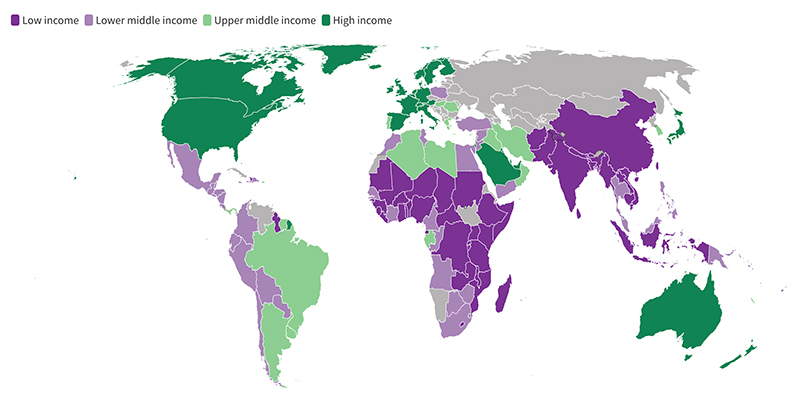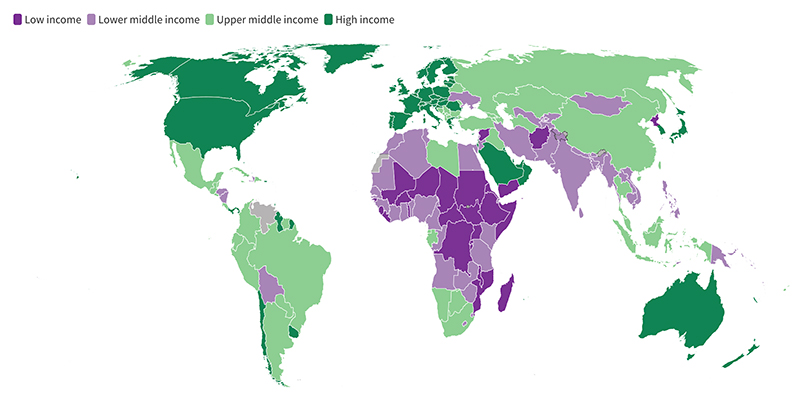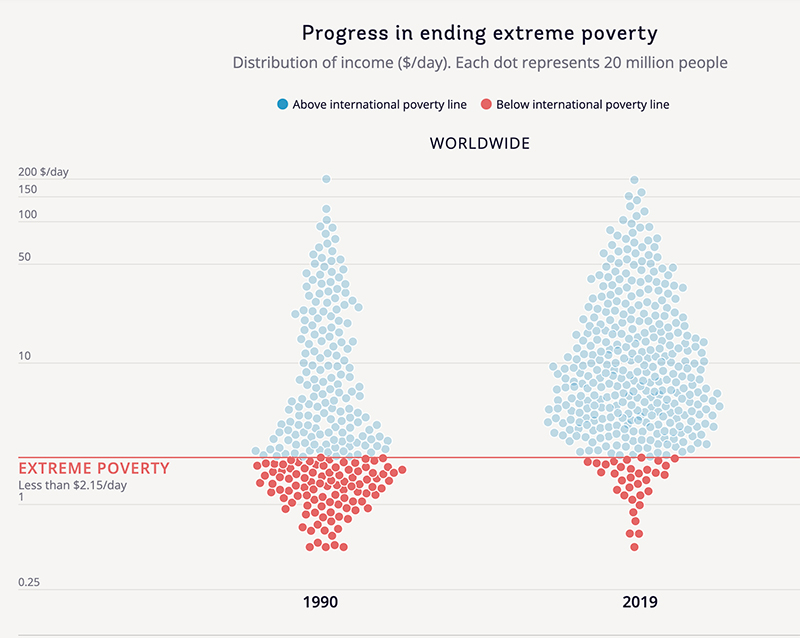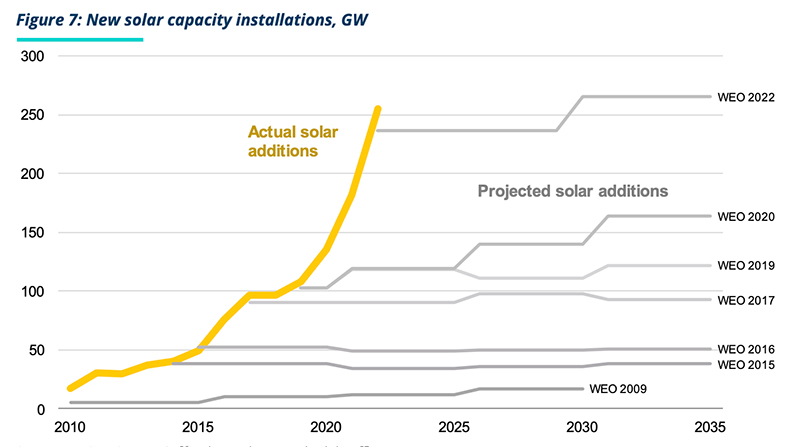Volcanoes are erupting in The Philippines, but on-fire Australia received some welcome rain. The Iran war cries have been called off and The Donald’s military powers are about to be hamstrung by the Senate. Meanwhile, his impeachment trial is starting, and we’re all on Twitter for a front-row seat.
What Could Go Right? Massive poverty drop
New data show that the change since 2000 is in the hundreds of millions.
This is our weekly newsletter, What Could Go Right? Sign up here to receive it in your inbox every Thursday at 6am ET. You can read past issues here.
Massive poverty drop
One good way to get a confused look in return is to remark that the world is becoming steadily richer and that hundreds of millions of people have been lifted out of poverty very recently. The part that is even more fun than the bafflement is that these statements are true! We have lots of fresh data released this month as proof.
Every year on July 1 the World Bank classifies countries into four levels: low income, lower middle income, upper middle income, and high income. These rankings are done by measuring gross national income (GNI) per capita—in other words, a country’s total income divided by its population. To get an idea of what the classifications look like, a country is low income with a GNI per capita of $1,135 or less, and high income with one of $13,846 or more.
Let’s look at the number of countries on the low end of income levels versus those on the high end in 1987. Lowest income is dark purple. Then, going up the wealth ranks, comes light purple, light green, and finally dark green for high income.

Compare that with the new data from 2022:

Much less dark purple, and much more green! That is great. The world is becoming steadily richer: check.
You might be asking, however, how useful these classifications are in assessing how an “average Joe” is living in one of these countries. After all, a GNI per capita could be driven higher with a small portion of the population raking in incredible dough while many Mr. Joes are scraping by.
That is a legitimate question that the World Bank is considering. “Seventy percent of those living in extreme poverty now live in middle income countries,” their report says, “although the extreme poverty rate in low income countries is extremely high, at around 50 percent.” So how much using GNI per capita really tells us is a question the World Bank has to resolve in deciding whether they want to change how their classifications are calculated. (So far they’re keeping the system as is, as there aren’t clearly better alternatives.)
But for our purposes, we’re interested in whether we can find out if everyday people are getting richer. It turns out that, looking at the bottom-most rung on the socioeconomic ladder, they are.
Per the World Bank, in 1990, almost two billion people worldwide lived in extreme poverty. But by 2019, despite rapid global population growth, the number of people living in extreme poverty dropped to around 700 million, a reduction of 1,300 million people. This means that the share of the global population living in extreme poverty dropped from 38 to 8.5 percent.

Again, great progress, but we can go even deeper with it. The World Bank measures extreme poverty as living on less than $2.15 per day. There is another way to measure poverty, however, that better takes into account standards of living, since the difference between $2.15 per day with education and clean water and useful assets like a refrigerator or a bicycle versus without all that is significant.
The United Nations’ July report on multidimensional poverty—a measurement that uses multiple factors to assess poverty instead of just income—says that 25 countries have halved their multidimensional poverty scores in the years post-2000. (You’ll see in the report that per their measurement, 1.1 billion people are currently living in “acute multidimensional poverty,” a higher number than the World Bank’s measurement of 700 million people living in “extreme poverty,” since more factors need to be in place to be considered no longer in multidimensional poverty.)
Countries that halved their scores include Cambodia, China, Congo, Honduras, India, Indonesia, Morocco, Serbia, and Vietnam. It’s not just the halving that is impressive, but also its speed. Some accomplished it in less than 15 years. Indonesia, for example, did it in five, and Thailand in four.
These countries’ scores also represent very large numbers of people. Some we have covered before in this newsletter, like India and China, with 415 million and 69 million people, respectively, lifted out of poverty since 2000. Nineteen million left poverty behind in Bangladesh, 8 million in Indonesia, and 5 million in Nigeria.
It is never all good news, of course. One caveat is that data post-pandemic is spotty, so the United Nations (UN) isn’t sure whether these positive trends are persisting—although they do note that the data from a small handful of countries that are available show that they are. Another is that the population in sub-Saharan Africa is growing so fast that the number of people living in poverty there is growing, because the population growth is outpacing the poverty reduction progress. There and East Asia are where governments and organizations will have to focus to end poverty completely.
But still, even judging by different measures, hundreds of millions of people have very recently been lifted out of poverty: we have our second check.
This progress is incredible, and it deserves more attention.
Quick hits
- Covid-19 milestone: During the pandemic’s worst phases, the total number of Americans dying each day was more than 30 percent higher than normal. For long stretches of the past three years, excess deaths were above 10 percent. Lately, however, excess deaths have fallen to almost zero.
- End of AIDS in sight: Imagine telling a person in the 80s that AIDS will be gone by 2030. The UN says it could be. Five African countries have hit UN targets for managing and preventing the spread of HIV, and 16 others are close to doing so.
Below in the links section, shark numbers are rising, India is going to the moon, Greece is legalizing same-sex marriage, and more.

Progress, Please
(Found good news? Tweet at us @progressntwrk or email.)
Other good stuff in the news 🦈
Energy & Environment:
- Colombia deforestation plummets as peace efforts focus on rainforest | The Guardian
- US cities turn old landfills into solar farms | Good Good Good
- New York’s shark-infested waters are a good thing. Yes, really. | Vox
- How Madrid reclaimed its river | Politico
- Green energy tycoon to launch UK’s first electric airline | The Guardian
- EV batteries can be repurposed as grid storage to reduce battery supply chain impacts | Utility Dive
- Inside Britain’s first heat pump village | Positive News
Public Health:
- Birth control isn’t the only thing that just went over-the-counter | The Atlantic
- As pandemic raged, global south lacked vaccines. Never again, researchers vow. | The Washington Post
- New rapid malaria test: A breakthrough by Angolan twins | DW
- Childhood immunization begins recovery after Covid-19 backslide | Unicef
Science & Tech:
- The 11 best images from Webb Space Telescope’s first year | Inverse
- Custom gene therapy hints at new path for rare disease treatments | Stat News
- AI tools are designing entirely new proteins that could transform medicine | Nature
- India’s historic Moon mission lifts off successfully | BBC
- NASA’s first humanoid robot Valkyrie is being tested at offshore energy facilities in Australia
| Euronews - Gene tech spares male chicks from cull by preventing them from hatching | Reuters
Politics & Policy:
- EPA sets stricter limits on hydrofluorocarbons used in refrigerators, air conditioners | AP
- Passenger rail finally arrives in Honolulu | Grist
- Philadelphia’s eviction diversion program kept thousands housed | The New York Times
Society & Culture:
- What if we had a 15-minute city for friendship? | Bloomberg
- Greece’s prime minister plans to legalize same-sex marriage | Time
Economy:
- The long-awaited recession might not come | CNBC
- How a simple tag helped India save fuel worth $8.4B | Rest of World
- ‘The fever is breaking’ as inflation takes long-awaited tumble | Axios
- Pay raises are finally beating inflation after two years of falling behind | The Wall Street Journal
TPN Member originals 🧠
(Who are our Members? Get to know them.)
- The tale of rising inequality turned out to be wrong | Yascha Mounk
- After affirmative action | Yascha Mounk
- ProPublica takes another look at Wuhan | James Fallows
- Stricter border control, more immigration | Matthew Yglesias
- How Obama (and Trump and Biden) beat Europe | Matthew Yglesias
- Learning from Europe’s doom loop of decline | James Pethokoukis
- Why we shouldn’t lose faith in organized religion | Eboo Patel
- Good grief: How to make the best of painful loss | Arthur C. Brooks
- Why Douglas Hofstadter is changing his mind on AI | David Brooks
- Philanthropy could learn a lot about diversity by studying what sports teams are doing right | Eboo Patel
- Avoiding a commercial real estate crash requires some imagination | Gillian Tett
- A conversation about vaccine safety | Isaac Saul
- America has always been problematic throughout history | Zachary Karabell
- Broken system: America’s secrets | Ian Bremmer
- Democrats’ Supreme Court ethics bill | Isaac Saul
- Biden to Netanyahu: Please stop trying to rush through your judicial overhaul. Build a consensus first. | Thomas L. Friedman
Department of Ideas 💡
(A staff recommendation guaranteed to give your brain some food for thought.)
In Defense of Independent Opinion Journalism | New York Magazine
The “hack gap” between right and left has been closing.
Why we picked it: Longtime liberal columnist Jonathan Chait reflects on whether progressives should be cheering the style of political activist journalism that has now grown popular on the left. Left or right, it behooves us to be aware if what we’re reading is meant to advance a political ideology or is a genuine attempt to deliver information or think through an issue. —Emma Varvaloucas
Until Next Time
What will your 6,000-year-old chewing gum tell archaeologists about you? 🤔



[…] What Could Go Right? Massive poverty drop Post navigation ← Previous Post […]